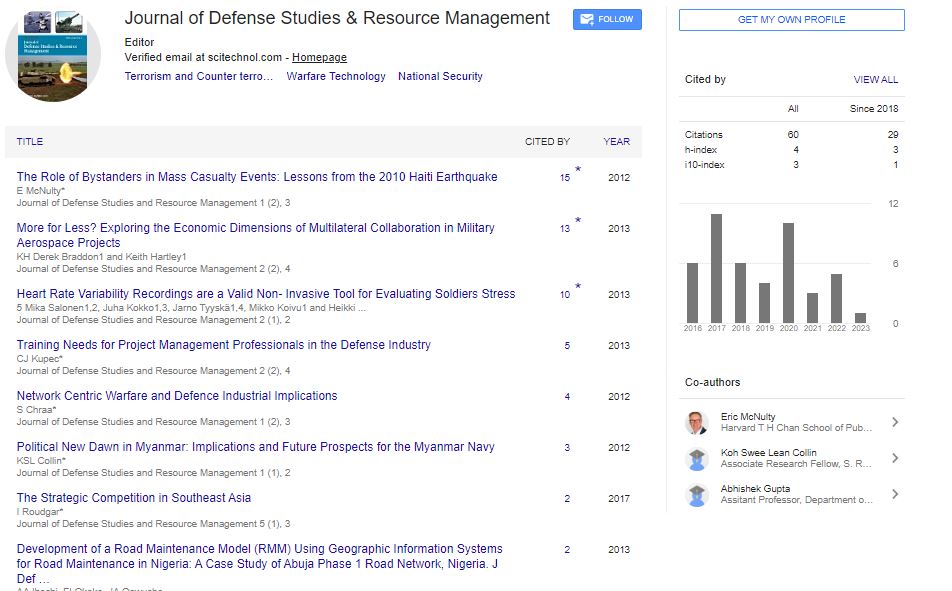Perspective, J Def Stud Resour Manage Vol: 11 Issue: 1
Innovations in Military Technology and their Implications for Resource Management
Noguchi Shimizu*
1Department of Economics and Business Administration, Kobe University, Kobe, Japan
*Corresponding Author: Noguchi Shimizu
Department of Economics and Business
Administration, Kobe University, Kobe, Japan;
E-mail: noguchi@shi.kobe-u.ac.jp
Received date: 01 March, 2023, Manuscript No. JDSRM-23-93374;
Editor assigned date: 03 March, 2023, Pre QC No. JDSRM-23-93374(PQ);
Reviewed date: 17 March, 2023, QC No. JDSRM-23-93374;
Revised date: 24 March, 2023, Manuscript No. JDSRM-23-93374(R);
Published date: 31 March, 2023, DOI: 10.4172/2324-9315.1000164
Citation: Shimizu N (2023) Innovations in Military Technology and their Implications for Resource Management J Plant Physiol Pathol 11:2.
Description
Innovations in military technology have always played a significant role in shaping the way wars are fought, and have been a driving force behind many of the advances in resource management. As new technologies are developed and deployed, they often have far-reaching implications for how militaries use and manage their resources, from personnel and equipment to logistics and supply chains.
One of the most significant innovations in military technology in recent years has been the use of Unmanned Aerial Vehicles (UAVs), commonly known as drones. Drones have transformed the way that militaries gather intelligence, conduct surveillance, and carry out airstrikes. By allowing for precise targeting and reducing the risk to human pilots, drones have made it possible for military planners to carry out complex missions with greater efficiency and precision. However, the deployment of drones has also created new challenges for resource management, particularly in terms of training and maintaining the necessary personnel to operate and maintain these systems.
Another area where technology has had a major impact on military resource management is in the development of new materials and manufacturing techniques. Advances in 3D printing, for example, have made it possible to produce complex parts and components ondemand, reducing the need for large stockpiles of spare parts and equipment. Similarly, new materials such as carbon fiber and advanced composites have enabled the development of lighter, more durable equipment that requires less maintenance and repair. However, the adoption of new materials and manufacturing techniques can also create challenges in terms of training and expertise, as well as supply chain management.
In the realm of logistics, new technologies such as autonomous vehicles and predictive analytics have the potential to revolutionize the way that military supply chains are managed. Autonomous vehicles can be used to transport personnel, equipment, and supplies with greater efficiency and speed, while predictive analytics can help military planners anticipate and respond to supply chain disruptions. However, the adoption of these technologies will require significant investment in infrastructure and training, as well as careful management of the data and algorithms that underpin them.
Perhaps the most significant implication of innovations in military technology for resource management is the need for increased coordination and collaboration between different branches of the military, as well as between the military and civilian organizations. As new technologies are developed and deployed, it is increasingly important for military planners to work closely with suppliers, manufacturers, and other stakeholders to ensure that the necessary resources are available and that they are used efficiently and effectively.
Innovations in military technology have had far-reaching implications for resource management, transforming the way that militaries use and manage personnel, equipment, and supplies. While these technologies offer significant advantages in terms of efficiency, precision, and effectiveness, they also present new challenges and require careful coordination and collaboration to ensure that resources are used in the most effective and sustainable way possible. As militaries continue to adopt and develop new technologies, it will be increasingly important to prioritize resource management and to develop the necessary expertise and infrastructure to support these innovations.
 Spanish
Spanish  Chinese
Chinese  Russian
Russian  German
German  French
French  Japanese
Japanese  Portuguese
Portuguese  Hindi
Hindi 